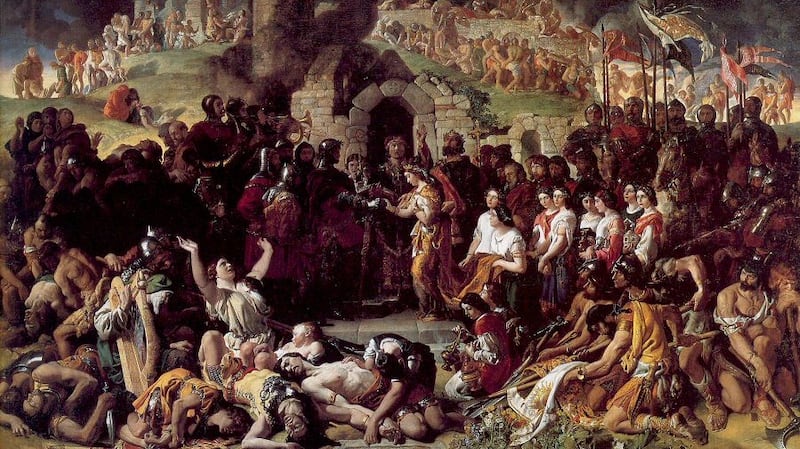Body modifications like tattoos have long since been a part of Irish culture, and are depicted in many ways throughout history - in both print and paint. Daniel Maclise’s masterpiece ‘The Marriage of Strongbow and Aoife’ in the National Gallery shows tattooed Irish warriors strewn out on the battlefield. While the practice of tattooing may have ancient roots, the modern art of tattooing has been made possible thanks to one particularly extraordinary member of the Irish diaspora.
Samuel O'Reilly was born in Connecticut in 1854 to Irish immigrant parents. Very little is known of O'Reilly's early years, but the 1870 Census (as discovered by Carmen Nyssen and Rich Hardy at Buzzworthy Tattoo History) shows the teenage Samuel O'Reilly as being employed in a clock shop, probably specialising in brass objects, given that the area he lived in was famed for its brass production.
O’Reilly was a bit of a wild teenager. He was something of a rebel and a law-breaker. By the time he was 19, he had left the clock shop and was making a living in much more unsavoury ways. This came to a head when, in 1873, he was arrested for burglary of a local convenience store. Despite being a minor at the time, O’Reilly and his two accomplices were sentenced to two years’ hard labour for their misdeeds.

When O’Reilly left prison, he briefly joined the Navy before deserting. Crucially, this is when it is believed that he learned the art of tattooing. From the Civil War period onwards, tattoos had become popular for American servicemen. But with this popularity came a rise in the stigma that only drunk and disorderly military men would get tattoos. As one American socialite put it, “It may do for an illiterate seaman, but hardly for an aristocrat.” O’Reilly would soon change this particular prejudiced perspective.
It is unclear when O’Reilly began tattooing, but he had certainly made a name for himself in the industry by the late 1880s. In 1875, he opened a tattoo studio in Chatham Square, in the rundown Bowery district of New York. His career was not just as a tattoo artist, but as a showman.
By 1890, he had been dubbed “Professor O’Reilly, the best tattooer [SIC] in the world and a perfect gentleman”. Many of the people he had tattooed had gone on to travel the world, exhibiting their painted skin. O’Reilly revelled in the publicity, fully embracing the attention of the curious public, and advertising his “painted people” attractions.

O’Reilly was crucial in developing upon one of Thomas Edison’s failed inventions, the electric pen, seeing the potential of this for the art of tattooing. Through experimentation, O’Reilly developed a machine which could make the job of a tattoo artist a lot easier - the handheld tattoo machine.
On December 8th, 1891, US Patent No. 464, 801 was successfully filed by O’Reilly, changing the face of modern tattooing. With hand-poking, even the most experienced artist can only puncture the skin two or three times a second. His machine increased this to around 50 perforations per second, completely revolutionising the tattoo industry.
O’Reilly’s fame and popularity skyrocketed. He was inundated with bookings and, since he could tattoo more people faster, tattoos became more popular and semi-normalised in all factions of American society. Even wealthy socialites requested “the Professor’s” services, though they dare not step foot in his Bowery Studio, preferring the artist come to them instead.
His popularity did not go unnoticed by other artists, some of whom were eager to get in on the machine-tattooing business. In 1900, O’Reilly brought a rival artist, Elmer Getchell, to court over Getchell’s alleged use of the famed patented tattoo machine. Though the case was never conclusively resolved, the pair did seem to have settled out of court.
By the turn of the century, tattoo studios were popping up in every major American city and O'Reilly's influence was spreading even further afield to Europe. Though he successfully managed to secure his legacy into the next century, he would not be around for much longer. He died in 1909 after falling while painting his house.
From infamy as a petty criminal to fame as an artist, the “Tattoo Man” Samuel O’Reilly’s life was certainly a colourful one.
This Extraordinary Emigrants article was written by Emily Glynn-Farrell of EPIC The Irish Emigration Museum (epicchq.com) in Dublin's Docklands, referencing original research compiled by Carmen Nyssen and Rich Hardy at Buzzworthy Tattoo History.















